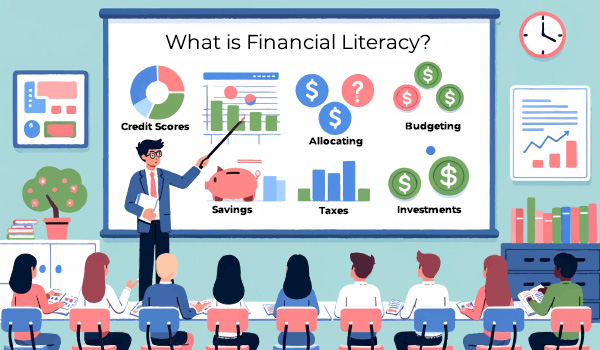What Is Financial Literacy?
Financial literacy refers to the knowledge and understanding of various financial concepts, tools, and practices that individuals need to make informed and effective decisions about their personal finances.
It encompasses a wide range of topics related to managing money, including budgeting, saving, investing, borrowing, and retirement planning. Financial literacy is essential for individuals to navigate the complex world of finance and make sound financial choices that align with their goals and values.

Why Financial Literacy Matters for Students
Financial literacy equips students with essential life skills, enabling them to make well-informed financial decisions and effectively manage their money throughout their lives. As students embark on their academic journeys, they may encounter various forms of debt, such as student loans and credit card debt, making it crucial to understand the implications of taking on debt and how to manage it responsibly.
Budgeting becomes a crucial skill in college life, helping students navigate expenses like tuition, housing, and everyday costs while preventing overspending and financial stress. Improved financial literacy also has the power to significantly boost your ability to accumulate wealth over time. When you understand how to save, invest, and make wise financial choices, your money can work for you, potentially leading to increased assets and financial security.
Making financially responsible decisions should become an integral part of your daily life, influencing how you manage your income, expenses, and debt. It impacts financial events like saving for the future, and even the way you approach major life events like buying a home, pursuing education, or planning for retirement. Understanding concepts like interest rates, credit scores, and financial scams also enables students to avoid common financial pitfalls and protect themselves.
Why Financial Literacy Matters for Students of Color
Financial literacy holds particular significance for students of color due to the unique financial challenges and disparities they often face. For these students, financial literacy serves as a critical tool for overcoming historical and systemic inequalities. It provides them with the knowledge and skills necessary to break free from the cycle of poverty and build a more secure future.
By understanding how to manage their finances effectively, students of color can work toward closing the racial wealth gap, which has persisted for generations. Many students of color are the first in their families to attend college, and the cost of higher education can be a significant barrier. With that said, financial literacy enables them to navigate student loans, scholarships, and work-study opportunities, ultimately reducing the burden of student debt.

What topics can I read to understand financial literacy?
Basic Financial Concepts:
- Income, expenses, and cash flow
- Financial goal setting
Budgeting and Money Management:
- Creating and maintaining a budget
- Tracking expenses
- Saving and emergency funds
Banking and Financial Institutions:
- Types of bank accounts
- Online banking and mobile apps
- Banking fees
Credit and Debt Management:
- Credit scores and reports
- Responsible credit card use
- Managing and reducing debt
Investing:
- Types of investments
- Risk and return
- Investment strategies
- Retirement Planning:
- Retirement accounts (e.g., 401(k), IRA)
- Compound interest and savings
Taxes:
- Income tax basics
- Tax deductions and credits
- Filing tax returns
Real Estate and Homeownership:

Strategies to Improve Financial Literacy Skills
To enhance your financial literacy skills, begin by exploring educational resources, such as books and online courses dedicated to financial literacy. Attend workshops or seminars for hands-on learning experiences and utilize mobile apps and financial planning tools to practice and apply your knowledge. Seek guidance from financial professionals when needed and engage in online communities and forums to exchange insights with others. Cultivate discipline in managing your finances, learning from any mistakes along the way.
Stay informed about financial news and trends and consider teaching your knowledge to others to reinforce your own understanding. Leverage technology for automation, set clear financial goals, and track your progress regularly. Networking with individuals knowledgeable in finance can also provide valuable insights.
Engaging Financial Literacy Activities for College Students
Why Financial Literacy Is Important for All Students
Financial literacy is universally essential for all students, regardless of their background or future career path. It equips them with the knowledge and skills necessary to navigate the complexities of personal finance, make informed decisions, and achieve financial security.
Students can better manage their money, avoid common financial pitfalls, and plan for long-term goals, ultimately setting a foundation for a more prosperous and independent future. It also fosters responsible financial behaviors and helps students contribute positively to their communities and the broader economy.
How to Teach the Basics of Financial Literacy
Teaching the basics of financial literacy involves utilizing resources and hands-on activities. Incorporate real-life case studies and encourage open discussions to make financial concepts relatable. Guest speakers and personal finance tools offer real-world insights, while role-playing exercises and practical assignments simulate financial decision-making.
Regular assessments help track progress, and students should be reminded that financial literacy is an ongoing journey.
Top Financial Literacy Activities
Understanding how to determine the percentage increase or decrease in the value of an investment over time.
Becoming familiar with taxes
Learning about various types of taxes, their implications on income and expenses, and how to file tax returns.
The Art of Budgeting
Developing the skill of creating a detailed plan for managing income and expenses to achieve financial goals.
Paying for College
Exploring options for funding higher education, including scholarships, grants, loans, and the associated financial considerations.
Living on Your Own
Preparing for the financial responsibilities of independent living, such as managing rent, utilities, groceries, and other living expenses.
Credit Cards
Understanding how credit cards work, their advantages and risks, and responsible usage to build and maintain good credit.
Cars and Loans
Exploring the process of buying a car, obtaining auto loans, and understanding the costs associated with car ownership.
Saving and Investing
Learning the importance of saving money, differentiating between saving and investing, and exploring various investment options.
Buying a Home
Understanding the steps involved in purchasing a home, including mortgages, down payments, and ongoing homeownership costs.
Your Personal Relationship to Money
This involves introspection and self-awareness to explore your unique attitudes, beliefs, and behaviors related to money. It encourages individuals to reflect on their personal financial experiences, family influences, and cultural factors that have shaped their views on money.
By understanding their money mindset, students can identify both positive and negative aspects of their relationship with money, such as spending habits, financial goals, and emotional reactions to financial challenges.
Further Reading

